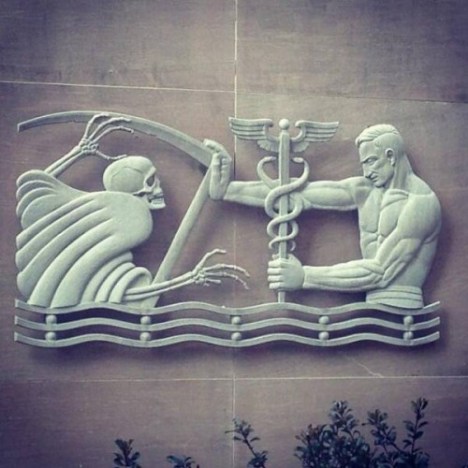Start-Ups for the End of Life
By MIT Technology Review
One Main Street
Cambridge, MA 02142
Technology has changed the way we grieve, but it’s also starting to make a difference to the way we deal with death’s logistics, too.
The New York Times reports that startups—often run by millennials, it drily notes—are increasingly creating digital tools that help people plan for their demise.
***

***
***
Assessment
Though for those determined not to admit defeat, cryogenics is still an option:
KrioRus, the only company outside of the U.S. prepared to put your head on ice after you die, will do so for a modest $12,000. It still doesn’t know what to do further down the line, though.
More:
- http://kriorus.com/en
- Life Science Startups Rising
- Do U Want to Get your Health Tech Start-Up Funded?
Conclusion
Your thoughts and comments on this ME-P are appreciated. Feel free to review our top-left column, and top-right sidebar materials, links, URLs and related websites, too. Then, subscribe to the ME-P. It is fast, free and secure.
Speaker: If you need a moderator or speaker for an upcoming event, Dr. David E. Marcinko; MBA – Publisher-in-Chief of the Medical Executive-Post – is available for seminar or speaking engagements. Contact: MarcinkoAdvisors@msn.com
OUR OTHER PRINT BOOKS AND RELATED INFORMATION SOURCES:
***
***
Filed under: Estate Planning, Ethics | Tagged: Cake, How Tech Is Streamlining Death, KrioRus, MIT Technology Review, Parting is, Willing |




















4 in 10 Seniors Have Not Documented End-of-Life Care Wishes
Kaiser Family Foundation recently released an infographic on Medicare and end-of-life care. Here are some key findings from the report:
• Of the 2.6 million deaths in 2014, 2.1 million were Medicare beneficiaries.
• The share of Medicare spending for end-of-life care was 13.5% in 2014.
• Medicare spent $34,529 per beneficiary for people who died in 2014.
• Medicare spending on hospice rose from $2.3 bil. in 2000 to $10.4 bil. in 2014.
• 70% of people over age 65 have not discussed end-of-life care with a physician.
• 4 in 10 people over age 65 have not documented their end-of-life care wishes.
Source: Kaiser Family Foundation, November 1, 2016
LikeLike
Inside Google’s Plan to Lengthen Life
The quest to slow aging is tantalizing, complex—and divisive. With $1.5 billion in the bank, Google’s spinout Calico is taking its own distinctive approach to the problem.
MIT Technology Review’s Antonio Regalado finds that the secretive company is, in effect, an elite university research group housed within a corporate bunker, doing mostly basic science. The company is studying yeast, worms, and even naked mole rats to find out how to help you live longer. “We believe you have to take a very long view,” says Calico’s Hal Barron, “and not rush into the clinic.”
Not everyone agrees. Aubrey de Grey, a proponent of interventions to slow aging, says Calico is built on “the assumption that we still do not understand aging well enough … to develop therapies.”
Some researchers are trying to develop interventions as quickly as possible, though—such as those from the Salk Institute, who yesterday announced that a new kind of gene therapy could rejuvenate mice. It remains to be seen which approach is best.
But, as Regalado points out, Calcio’s large bank balance will come in useful for finding out.
MIT Technology Review
LikeLike
More on euthanasia
Elderly couple got ‘deepest wish’ — to die together — in rare euthanasia case.
http://www.msn.com/en-us/news/world/elderly-couple-got-%e2%80%98deepest-wish%e2%80%99-%e2%80%94-to-die-together-%e2%80%94-in-rare-euthanasia-case/ar-AAqg1Uc?li=BBnbfcL
Dr. David Marcinko MBA
LikeLike
Virtual reality death simulator could ‘cure society’s fear of dying’
Scientists use headsets to stimulate the feeling of passing away and leaving your body
https://www.thesun.co.uk/news/2694271/virtual-reality-death-simulator-could-cure-societys-fear-of-dying/
Dr. David Marcinko MBA
LikeLiked by 1 person
AQUAMATION not Cremation
https://www.msn.com/en-us/news/world/aquamation-tutus-chosen-flameless-cremation/ar-AASlQmD?li=BBnb7Kz
DEM
LikeLike
DEATH DOULAS
https://time.com/6128469/death-doulas-covid-19-pandemic/?utm_source=pocket-newtab
Dr. David Marcinko MBA
LikeLike
DAWKINS on DEATH
https://getpocket.com/explore/item/richard-dawkins-on-the-luckiness-of-death?utm_source=pocket-newtab
Dr. David Marcinko MBA
LikeLike
[…] RELATED: https://medicalexecutivepost.com/2022/02/24/how-technology-is-streamlining-death/ […]
LikeLike